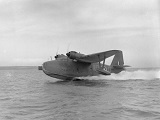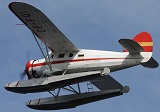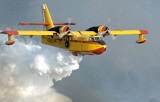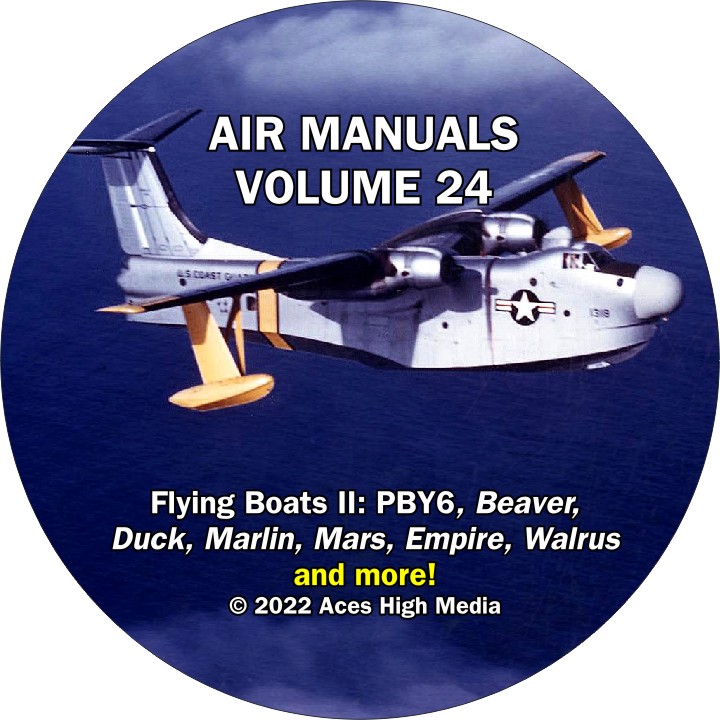Aces High Air Manuals
Volume 24: Seaplanes and Flying Boats Disc 2

|
Consolidated PBY-6A Pilot's Handbook of Flight Operating Instructions
99 pages
The Consolidated PBY Catalina, also known as the Canso in Canadian service, was an American flying boat, and later an amphibious aircraft of the 1930s and 1940s produced by Consolidated Aircraft. It was one of the most widely used seaplanes of World War II. Catalinas served with every branch of the United States Armed Forces and in the air forces and navies of many other nations.
During World War II, PBYs were used in anti-submarine warfare, patrol bombing, convoy escorts, search and rescue missions (especially air-sea rescue), and cargo transport. The PBY was the most numerous aircraft of its kind and the last active military PBYs were not retired from service until the 1980s. In 2014, nearly 80 years after its first flight, the aircraft continues to fly as a waterbomber (or airtanker) in aerial firefighting operations all over the world. The PBY-6A model covered here is a U.S. Navy amphibious version with two 1,200 hp R-1830-92 engines and a taller fin and rudder than earlier models. Radar scanner fitted above cockpit and two 0.5 in nose guns; 175 built including 21 transferred to the Soviet Navy. |

|
De Havilland Canada DHC-2 Beaver Flight Manual
97 pages
The de Havilland Canada DHC-2 Beaver is a single-engined, high-wing, propeller-driven, STOL aircraft developed by de Havilland Canada, primarily known as a bush plane. It is used for cargo and passenger hauling, aerial application (crop dusting and aerial topdressing), and has been widely adopted by armed forces as a utility aircraft. The United States Army purchased several hundred; nine DHC-2s are still in service with the U.S. Air Force Auxiliary (Civil Air Patrol) for search and rescue. A Royal New Zealand Air Force Beaver supported Sir Edmund Hillary's expedition to the South Pole. Over 1,600 Beavers were produced until 1967 when the original assembly line shut down.
Photo credit: Robert Frola (GFDL) |

|
De Havilland Canada DHC-3 Otter Flight Manual
137 pages
The de Havilland Canada DHC-3 Otter is a single-engined, high-wing, propeller-driven, short take-off and landing (STOL) aircraft developed by de Havilland Canada. It was conceived to be capable of performing the same roles as the earlier and highly successful Beaver, but is overall a larger aircraft.
Photo credit: CanadianBushPilot (CC BY-SA 3.0) |

|
De Havilland Canada DHC-6 Twin Otter Airplane Flight Manual
116 pages
The de Havilland Canada DHC-6 Twin Otter, currently marketed as the Viking Air DHC-6 Twin Otter, is a Canadian 19-passenger STOL (Short Takeoff and Landing) utility aircraft developed by de Havilland Canada and currently produced by Viking Air.
Twin Otters could be delivered directly from the factory with floats, skis or tricycle landing gear fittings, making them adaptable bush planes for remote and northern areas. Areas including Canada and the United States, (specifically Alaska) saw much of the demand. Many Twin Otters still serve in the far north, but they can also be found in Africa, Australia, Asia, Antarctica and other regions where bush planes are the optimum means of travel. Photo credit: Tony Hisgett (CC BY 2.0) |

|
Grumman J2F-6 Duck Pilot's Handbook of Flight Operating Instructions
38 pages
The Grumman J2F Duck (company designation G-15) was an American single-engine amphibious biplane. It was used by each major branch of the U.S. armed forces from the mid-1930s until just after World War II, primarily for utility and air-sea rescue duties. It was also used by the Argentine Navy, who took delivery of their first Duck in 1937. After the war, J2F Ducks saw service with independent civilian operators, as well as the armed forces of Colombia and Mexico.
The J2F was an improved version of the earlier JF Duck, with its main difference being a longer float. |

|
Martin P5M-2 Marlin Flight Handbook
290 pages
The Martin P5M Marlin (P-5 Marlin after 1962), built by the Glenn L. Martin Company of Middle River, Maryland, was a twin-engined piston-powered flying boat that entered service in 1951 and served into the late 1960s with the United States Navy performing naval patrol. It also served with the United States Coast Guard and the French Navy. Two hundred eighty-five were produced overall.
|

|
Martin JRM-1 Mars Pilot's Handbook
101 pages
The Martin JRM Mars is a large, four-engined cargo transport seaplane originally designed and built in limited numbers for the U.S. Navy during the World War II era. It was the largest Allied flying boat to enter production, although only seven were built. The United States Navy contracted the development of the XPB2M-1 Mars in 1938 as a long range ocean patrol flying boat, which later entered production as the JRM Mars long range transport.
Four of the surviving aircraft were later converted for civilian use to firefighting water bombers. One example of the aircraft still remains in limited service at Sproat Lake, British Columbia. Photo credit: Alex Juorio (CC BY 2.0) |

|
Saunders-Roe (Saro) A.36 Lerwick Pilot's Notes
137 pages
The Saunders-Roe A.36 Lerwick was a British flying boat built by Saunders-Roe Limited (Saro). It was intended to be used with the Short Sunderland in Royal Air Force Coastal Command but it was a flawed design and only a small number were built. They had a poor service record and a high accident rate; of 21 aircraft, 10 were lost to accidents and one for an unknown reason.
|

|
Short Empire Handbook
180 pages
The Short Empire was a medium-range four-engined monoplane flying boat, designed and developed by Short Brothers during the 1930s to meet the requirements of the growing commercial airline sector, with a particular emphasis upon its usefulness upon the then-core routes that served the United Kingdom. It was developed and manufactured in parallel with the Short Sunderland maritime patrol bomber, which went on to serve in the Second World War; a further derivative that was later developed was the piggy-back Short Mayo Composite.
The development of the Short Empire had been heavily influenced by its primary customer, Imperial Airways, who had originally developed the requirements to which it was initially ordered and designed from. Imperial Airways, and its successor, the British Overseas Airways Corporation (BOAC), along with Qantas and TEAL, operated the type in commercial service. Upon entering service, the Empire routinely flew between the British mainland and Australia and the various British colonies in Africa and Asia, typically carrying a combination of passenger and mail cargoes; the Empires were also used on various other routes, such as on the service between Bermuda and New York City. The Empire also saw military service during the Second World War. The Royal Air Force (RAF), Royal Australian Air Force (RAAF), Royal New Zealand Air Force (RNZAF), and briefly the Royal Canadian Air Force (RCAF) used the type to conduct various military operations, particularly at an airborne platform for anti-submarine patrols and for general transport duties. |

|
Supermarine Walrus Pilot's Notes
289 pages
The Supermarine Walrus (originally known as the Supermarine Seagull V) was a British single-engine amphibious biplane reconnaissance aircraft designed by R. J. Mitchell and first flown in 1933. It was operated by the Fleet Air Arm (FAA) and also served with the Royal Air Force (RAF), Royal Australian Air Force (RAAF), Royal New Zealand Navy (RNZN) and Royal New Zealand Air Force (RNZAF). It was the first British squadron-service aircraft to incorporate in one airframe a fully retractable main undercarriage, completely enclosed crew accommodation and all-metal fuselage.
Designed for use as a fleet spotter to be catapult launched from cruisers or battleships, the Walrus was later employed in a variety of other roles, most notably as a rescue aircraft for downed aircrew. It continued in service throughout the Second World War. |

|
United Consultants Corporation UC-1 Twin Bee Flight Manual
57 pages
The United Consultants Twin Bee is an American twin-engined light amphibian aircraft of the 1960s.
The UC-1 is a major conversion of the RC-3 Seabee airframe. The single pusher engine is deleted and this allows an additional fifth seat to be fitted beneath the old installation. The twin 180hp Lycoming engines, mounted in tractor configuration, are fitted in the wing, fairly close to the cabin. This required the rear cabin windows to be reduced in size, supplemented by a porthole-type window each side of the rear of the enlarged cabin. The considerable extra engine power of Twin Bee proved to be attractive to private owners, as the aircraft has STOL takeoff and landing ability. 15 of the 23 conversions were currently registered in the United States in April 2009. Other examples are active in Switzerland and the Philippines. Photo credit: RuthAS (CC BY 3.0) |

|
Noorduyn C-64A Norseman Pilot's Flight Operating Instructions
60 pages
The Noorduyn Norseman is a Canadian single-engine bush plane designed to operate from water and unimproved surfaces.
Originally introduced in 1935, the Norseman remained in production for almost 25 years with over 900 produced. A number of examples remain in commercial and private use to this day. Norseman aircraft are known to have been registered and/or operated in 68 countries throughout the world and also have been based and flown in the Arctic and Antarctic regions. Photo credit: CanadianBushPilot (CC BY-SA 3.0) |

|
Canadair CL-215 Scooper Flight Manual
263 pages
The Canadair CL-215 (Scooper) was the first model in a series of firefighting flying boat amphibious aircraft built by Canadair and later Bombardier. The CL-215 is a twin-engine, high-wing aircraft designed to operate well at low speeds and in high gust-loading environments, as are found over forest fires.
Photo credit: Javiramos43 (CC BY 3.0) |


A total of 297 BV 138s were built between 1938 and 1943.
Sprechen-sie deutsch? This manual is in German.